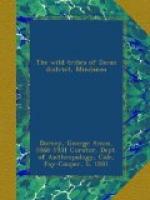“There are not, as a rule, many thefts among the Bagobo, for they believe that a thief can be discovered easily by means of their famous bongat. That consists of two small joints of bamboo, which contain certain mysterious powders. He who has been robbed and wishes to determine the robber takes a hen’s egg, makes a hole in it, puts a pinch of the above said powder in it, and leaves it in the fire. If he wishes the robber to die he has nothing else to do than to break the egg; but since the thief may sometimes be a relative or a beloved person, the egg is not usually broken, so that there may be or may be able to be a remedy. For under all circumstances, when this operation is performed, if the robber lives, wherever he may be, he himself must inform on himself by crying out, ‘I am the thief; I am the thief,’ as he is compelled to do (they say) by the sharp pain which he feels all through his body. When he is discovered, he may be cured by putting powder from the other joint into the water and bathing his body with it. This practice is very common here among the heathens and Moros. A Bagobo, named Anas, who was converted, gave me the bongat with which he had frightened many people when a heathen.”
In Bansalan crab shells are hung over the doors of houses, for these shells are distasteful to the buso who will thus be kept at a distance.
I was frequently told of persons who could foretell the future by means of palmistry, but was never able to see a palmist at work, or to verify the information.
MUSIC, DANCES AND CEREMONIES.
The music for the dances is generally furnished by one or more persons beating on several agongs of different sizes and notes, which are suspended in regular order from the house rafters (Plate XXXa). The player stands in front of the line and begins to beat the instruments with a padded stick. Oftentimes he is accompanied by a man who strikes a wooden drum with the palm of one hand and a stick held in the other. The music grows faster, emphasizing certain beats, until it becomes a compelling rhythm that starts the feet of the onlookers, and suddenly a man or woman begins to dance. At first she keeps time to the music by raising on her toes and heels, bending the knees and twisting the body from side to side, but soon she becomes more animated, the feet are raised high above the floor and brought down with a sort of shuffle which reminds one of the sound made by the feet of a clog dancer. Still swaying her body, she begins to circle, contra-clockwise, around the gongs, and soon she is joined by others until all the dancing space is filled. The scene is most picturesque, for these dances usually occur at night, in rooms illuminated only by the flickering light of torches. The rich clothing of the participants loses nothing of its beauty in this dim light, while the bells and rattles with which each dancer surrounds arms, legs and ankles, add to the din and weirdness of the occasion. Before the dance has progressed far the musicians begin to keep time with their feet and frequently dance away from their instruments, circle, and then return to continue the music.




